Motorcycle Trip Preparation
Preparing for a trip won't guarantee that the trip will be perfect, but hopefully it will be less ... Adventurous. Every trip you learn a little more to make the next trip better. Take small trips, day trips then make them longer. You will learn what you need (and more importantly) what you do NOT need. You don't have much for packing, so be careful in what you choose to take... Figure out what you can buy on the road.
No matter how much you prepare you will almost CERTAINLY have an event (maybe good or not so good) that you didn't even think of ... Like running into a group of motorcyclists and airplanes at the gas station. Mixing Motorcycles and Airplanes. What could go wrong with that?
The trip is the story. The person that lived it gets to tell it. There are stories I tell, and there are stories from the people I ride with, the stories may not match :-).
Below I describe packing for two kinds of trips. Staying in motels (easier) or motorcycle camping. The only difference is that I add equipment when motorcycle camping. None of the below links are affiliate links, all of it is equipment that I bought and I use. I will tell you the good and bad below or if you ask me.
Remember you can ALWAYS buy something on the road if you leave something behind. Also, on a plane or ship - Looking forward from behind - Port - 4 letters, left. Starboard - Right.
Also try to think about using the same thing in two different ways. My dry bag not only stores my clothes but also acts as a pillow, with the hoddie I carry adding a little extra padding. My gear sits at the bottom of the tent and acts as a leg rest if I need it or extra covers if it gets too cold. The tent is a backrest for me while I ride.
Where to stay - That is the question. Motels are cheaper at maybe $100 per night, Hotel rooms are $140 or more per night and you have all the amenities. Camping at BLM (Bureau of Land Management) can be free or $5 per night (no amenities), KOA can be $40 per night (shower, water, electricity, Wi-Fi), State campgrounds $8 to $15 to $30 with sometimes water and electricity or not. Do some research, there are articles about motorcycle camping on the interwebs. Your route may help with decisions about where to stay. My personal guide is 1 to2 days camping with 1 day in a motel / hotel. My first motorcycle campig trip was my trip to John Day Fossil Bed and Hells Canyon, I give some points in that description.
Travel light - Stay in Motels
You have a few choices. The fastest and easiest way to travel is to stay in hotels / motels with a minimal amount of baggage. I would suggest, at a minimum, the GPS and the repair and maintenance kit. In fact I carry the maintenance kit with me on a regular basis.
GPS / Navigation
 Worst case you COULD travel with only a navigation system. You could buy everything on the road and take a chance that your bike will work perfectly for many miles. At the VERY least I would suggest getting some kind of navigation system other than a phone. Mine is a Garmin Zumo GPS for the motorcycle, VERY glad I got one. I bought one used 'just in case' but in the end it worked very nicely. This GPS has the LM (Lifetime Maps), look for that designation and you won't have to worry about buying maps every few years. Two issues, you cannot do a route as far as I know that is circular (start and end at the same point), create two different routes. The other issue WITH MINE is the glare. Later versions have that fixed from what I have been told.
Worst case you COULD travel with only a navigation system. You could buy everything on the road and take a chance that your bike will work perfectly for many miles. At the VERY least I would suggest getting some kind of navigation system other than a phone. Mine is a Garmin Zumo GPS for the motorcycle, VERY glad I got one. I bought one used 'just in case' but in the end it worked very nicely. This GPS has the LM (Lifetime Maps), look for that designation and you won't have to worry about buying maps every few years. Two issues, you cannot do a route as far as I know that is circular (start and end at the same point), create two different routes. The other issue WITH MINE is the glare. Later versions have that fixed from what I have been told.
Look at your maps and REVIEW the route
Get some Butler Maps for the states you will travel in. These maps show you the BEST curvy rides. I look at the route and compare it against Butler Maps for the best route. If you see mountain roads or passes (those are usually the MOST fun) be SURE to go to the local road condition sites for that state / local government and see if the passes are even open.
Once your trip is done you can put it on a Google or Bing map if you want to show it to others, that is what I have done with my maps on my trip pgaes. All of my scripts for taking the GPX file from Garmin for Motorcycle and Hiking trips and turning them into maps in your browser. Read the comments in the script for instructions. GitHub:
GandalfDDI Github
The maps were created by the PowerShell script
Convert_gpx_to_Google_Plot_VX.Y.ps1
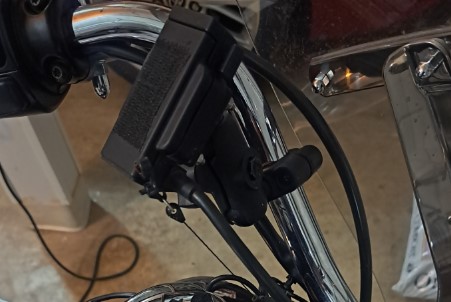 The script spits out a daily .csv file (instructions for plotting in Google are in the script). To get a plot of the entire path you just copy / paste all the days together into ONE file ... BUT ... if you have more than 2,000 points (which is easy to do for more than one day) then Google won't plot, so run the following script and it will chop out enough intermediate points to make the number of points = or less than 2000:
The script spits out a daily .csv file (instructions for plotting in Google are in the script). To get a plot of the entire path you just copy / paste all the days together into ONE file ... BUT ... if you have more than 2,000 points (which is easy to do for more than one day) then Google won't plot, so run the following script and it will chop out enough intermediate points to make the number of points = or less than 2000:
Convert_gpx_to_2000_points_VX.Y.ps1
Note: Open the .html files that the PowerShell script creates in Google Chrome for the best experience.
I mounted the GPS on the handlebars using a Handlebar Ball Mount. While I could probably clean up the wires a little better it works for now:
Traveling in the west and Canada/Alaska
When you travel in the western United States and in Canada / Alaska you MUST map out your gas stops. I have seen multiple signs that state 'Next Service XXX Miles'. KNOW your range, if you are going to be close buy a fuel bladder to carry along.
When I plan my trip for western Canada / Alaska I am going to buy the travel directory The MILEPOST. I was able to take a look at the directory while on a trip to Alaska and it is VERY good. Literally a mile by mile description of the roads and what services are available.The MILEPOST main page has a TON of other suggestions on what to visit. There is also a page specifically for riding your bike in the north.
Repair and Maintenance - Port Side Saddle Bag / Pannier
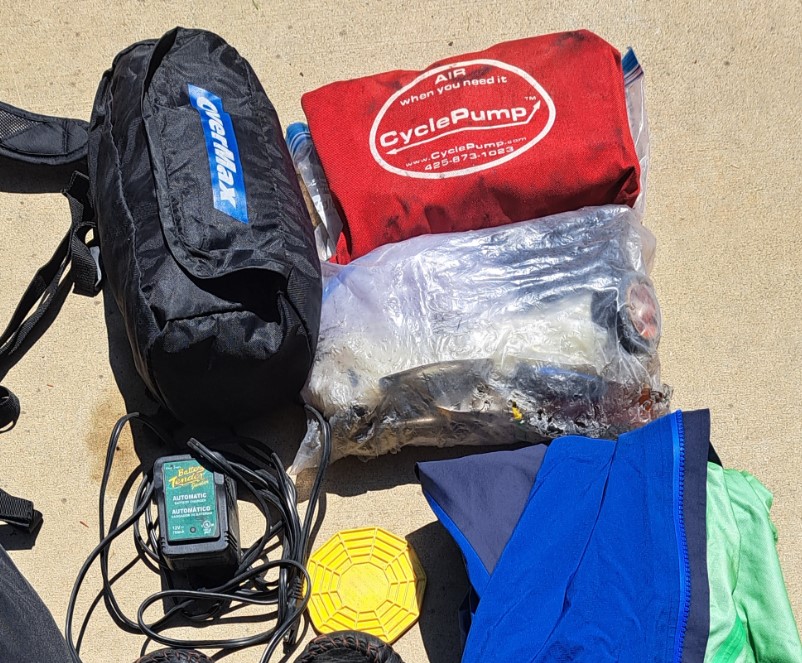 These are the items I put in my left side pannier, the pannier I only open rarely.
These are the items I put in my left side pannier, the pannier I only open rarely.
- CyclePump Tire Inflator. Having this and a tire repair kit saved me on a 3500 mile trip when my tire deflated in the middle of nowhere. Fixed the tire and was on my way.
- Inside the Cyclepump bag I also have:
- Small hammer with a claw to pull out nails and hammer in the plug
- A Digital Tire Pressure gauge, a cheap one works well. If you lose it any Auto Zone or WalMart should have one.
- The tire repair kit: I have is a simple nail coated in rubber that you pound into the hole. It is for tubeless tires (I have a tube now, we will see if it works or not). I could not find that kit any more but you DO want something that will fix your tire quickly. The Mushroom Plug kit and Rubber Plug kit seem to be popular. The caveat is that on a Motorcycle you MUST get your tire repaired as soon as you can. If you get a puncture in your tire don't just plug/patch the tire and assume you are good. Manufacturers have different guidance on what you should do, some say replace immediately. Worst case since you are on a motorcycle you should consider replacing as soon as possible. When a tire is punctured it no longer rated at the speed rating listed on the tire.
- A bag of tools that fit the bike I am riding. Many times the bike will come with a manufacturer bag. Or you can buy a kit from the manufacturer (like Harley). You will figure out what you need for your repair kit but DEFINITELY have Cable Ties, duct tape (I like Gorilla Tape. There are LOTS of opinions on what a good Emergency Tool Kit looks like.
- A Motorcycle Side Stand Puck. The puck is the yellow 10 sided round thing in the picture. You put this under your kickstand when you are on soft sand or dirt so that your jiffy / kick / side stand doesn't sink into the sand and your bike falls over.
- A Battery Tender / Charger. This allows you to charge your battery in case you mess up & leave something on during the night. Hopefully there is power nearby. Again, I only used it once but once was enough.
- Speaking of charging a battery, depending on how much you trust your battery a portable jump starter will keep you from being stranded out in the middle of nowhere
- A Rain cover. Keeps the bike dry at night or if you get caught up in a storm and little shelter
Luggage - Starboard side Pannier / Saddle Bag
 I usually carry the items I need quick access to on the right pannier. A long sleeve hoody and a rain jacket in case it either gets cold or rain starts.
I usually carry the items I need quick access to on the right pannier. A long sleeve hoody and a rain jacket in case it either gets cold or rain starts.
I also keep drinks / water in the saddle bag. When camping (see below) I keep the other loose items (JetBoil, bear spray, propane cannister) in the pannier also.
Luggage - Top
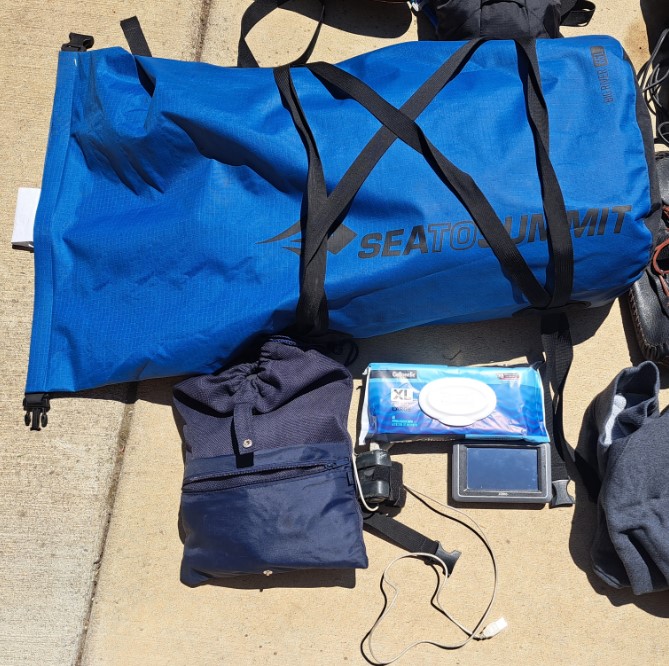 It is VERY important when strapping bags or the tent to your motorcycle that you do NOT use bungee cords. They STREEEETCH when you go around corners and your load may start moving around. I use 1 inch Straps with a buckle and tighten so that they do not come loose.
It is VERY important when strapping bags or the tent to your motorcycle that you do NOT use bungee cords. They STREEEETCH when you go around corners and your load may start moving around. I use 1 inch Straps with a buckle and tighten so that they do not come loose.
Vendors make bags that fit your panniers perfectly so that you can pack everything in the bag then slide it into the panniers. I had these bags for the K1600 and they worked pefectly, but they were inside the top box and side panniers, protected from weather. The problem was that when I strapped that bag on the Harley pillion seat since the bag was not waterproof everything inside got wet. I bought a 65 Liter Big River Dry Bag at REI and that has worked perfectly for me. Note that I have 4 ea. 1 inch straps to hold just that bag on.
Inside the dry bag I put:
- A bag that holds tooth paste, tooth brush, medicine, shampoo, nail clipper, shaver, everything for the morning routine
- Shirt, socks, underwear for each day - Max 7 days
- Pants - I can usually wear a pair of pants for 2 days in a row.
- Pillowcase - To put dirty clothes into
- A pair of Minnetonka Moccasins so that if you have to get up late at night you don't have to pull on your motorcycle boots
- Towel - If you will be camping
- Extra Large (adult) wipes - If you will be camping so that you can clean up somewhat if no shower is available
- If the trip is more than 7 days I will have to do laundray - And in that case small laundry pods for the Laundromat and a couple of rolls of quarters
Luggage - Misc
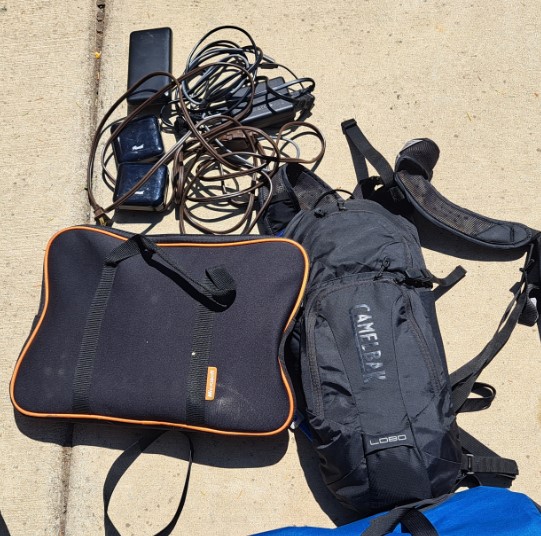 I bring along my computer so that I can transfer each day's video over to a hard drive. I put the computer bag in either the dry bag or I put it in the right pannier if there is room and I am out camping.
I bring along my computer so that I can transfer each day's video over to a hard drive. I put the computer bag in either the dry bag or I put it in the right pannier if there is room and I am out camping.
I always run my camera on my shoulder, hence the need for the laptop
In that that large computer bag is:
- A very small laptop - This is why I like the Surface computer, very small and leaves lots of room in the laptop case
- Portable hard drive to back up all your pictures and videos
- Several rechargeable power banks for the camera, bluetooth helemet headset and phone. You especially will need several if you are going camping. I bring along 4 ea. 10000 mAh power banks. Don't look for the absolute cheapest and lightest. They may have a power capacity MUCH LOWER than what they are telling you it is.
- A good USB charger for when you DO have power available to charge everything.
- Extra USB cords
- Extension cord
Also a Camelback backpack to hold 2L of water so that if anything happens I have water or if I am camping I have a water supply. In the west there are LOTS of long desolate lonely highways.
Motorcycle Camping
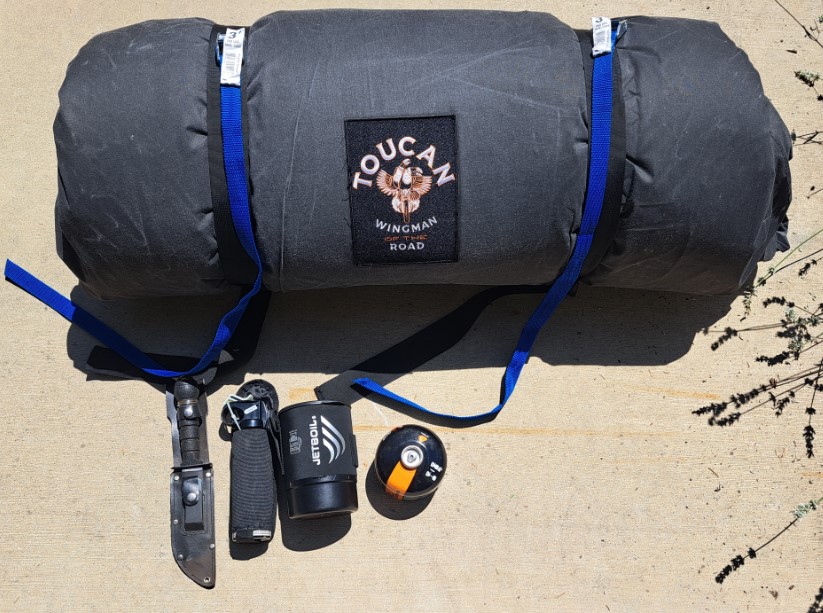 For motorcycle camping there are LOTS of resources online with lists of things to take. The key here is 'essentials', too much stuff and it may not all fit. Look at a few to see what you may want to bring along.
For motorcycle camping there are LOTS of resources online with lists of things to take. The key here is 'essentials', too much stuff and it may not all fit. Look at a few to see what you may want to bring along.
Add to the list:
- A tent - I really like the Wingman of the road Toucan. Comfortable and is good in any weather from what I have seen so far
- Two more 1 inch Straps with a buckle to tie your tent to your motorcycle seat
- The Pendleton Mills 'In Their Element' twin size blanket, fits PERFECTLY in the tent
- A can of Bear Spray. As much for humans as for wild animals
- A good knife, might be useful
- Flashlight or headlamp for those putch dark nights
- The Jetboil Flash cooking, boils coffee VERY fast. It comes with the bottom orange stabilizer but you will need to buy a propane can
- If you do decide to camp at places without electricity for more than 2 days you should consider buying a USB Charger that you can connect to your batter tender cable or directly to your battery
Packing your tent
As you can see from the picture below, before I roll the tent up I have not drawn the ties as close together as I could. This is so that when I roll the tent it is a little wider. Remember, I have that extra Pendleton blanket inside the tent. With the ties situated like they are when I roll up the tent I use the built-in tie straps to help keep the roll the size I want. I then use two additional 1 inch straps to hold it in place / tied to the motorcycle seat back. The tent now fits my back perfectly as a backrest. If I needed the tent to support my back more I would just tie the 4 ties a little closer making the tent a little rounder:

When putting in all together as I said the tent goes right behind me where a passenger would go with straps holding the tent to the seat. The Dry Bag gets strapped to the seat and through the tent straps. The Camelback is squeezed in between the dry bag and the seat, otherwise if you strap the Camelback on top the sun heats up the water.
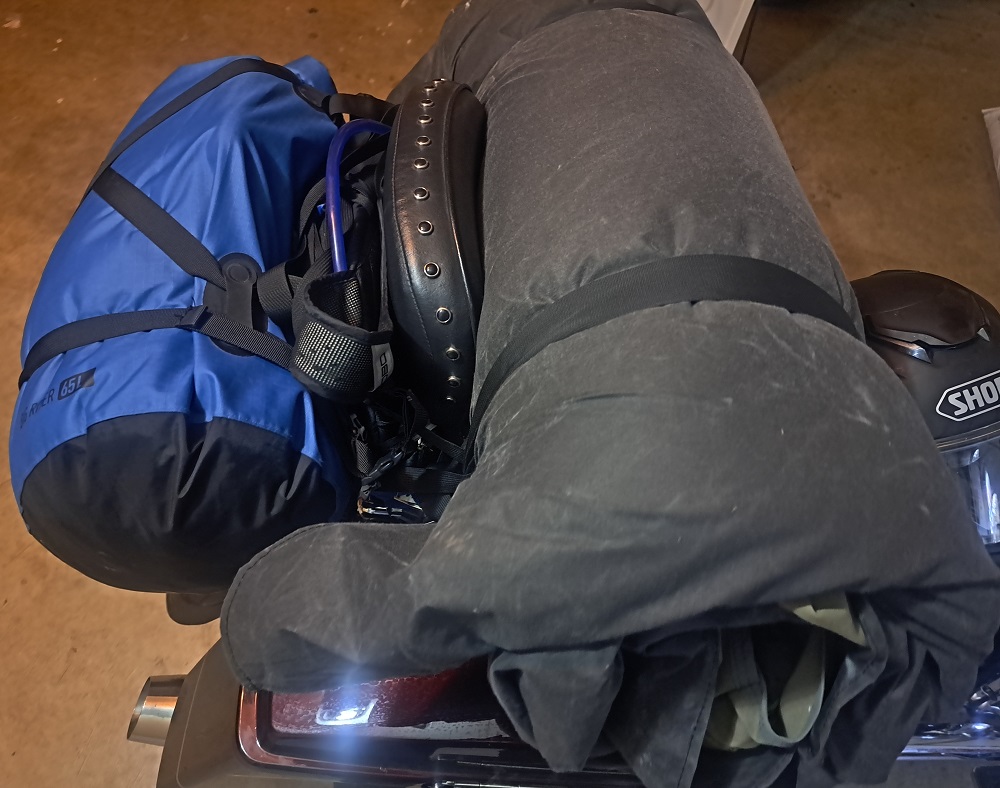
Panoramic Pictures
My panorama pictures are spliced together using Image Composting Editor, take at least 9 pictures and up to 20 pictures of the landscape and ICE splices them together:
https://www.microsoft.com/en-us/research/product/computational-photography-applications/image-composite-editor/
The GREAT things I like about these pictures are:
- All of the picture is in focus including the grass at the bottom of pictures
- If you take the picture correctly the clouds are the right color (not too bright) and the trees on the mountain are visible and the correct color of green
- There is more detail in the picture as you zoom in
- I also use Gimp to 'edit' out other people that are in the pictures using the 'clone' tool. If you see a repeated pattern in my picture that is probably why
- There are issues
- The pictures do not always align well (I use Gimp to fix those issues)
- They DO come out HUUUGE (but Gimp can fix that also)
- Use the ICE Automatic image completion to fill in parts of the picture that need to be filled in
- The shadows sometimes do not align / have the same shades
Motorcycle Home
Any questions or comments send me e-mail
Username = "GandalfDDI"
E-Mail = "Outlook.Com"
Obviously to send me e-mail just put the preceding two together --> Username@E-Mail (this is to minimize the amount of SPAM I get thank you)
 Worst case you COULD travel with only a navigation system. You could buy everything on the road and take a chance that your bike will work perfectly for many miles. At the VERY least I would suggest getting some kind of navigation system other than a phone. Mine is a Garmin Zumo GPS for the motorcycle, VERY glad I got one. I bought one used 'just in case' but in the end it worked very nicely. This GPS has the LM (Lifetime Maps), look for that designation and you won't have to worry about buying maps every few years. Two issues, you cannot do a route as far as I know that is circular (start and end at the same point), create two different routes. The other issue WITH MINE is the glare. Later versions have that fixed from what I have been told.
Worst case you COULD travel with only a navigation system. You could buy everything on the road and take a chance that your bike will work perfectly for many miles. At the VERY least I would suggest getting some kind of navigation system other than a phone. Mine is a Garmin Zumo GPS for the motorcycle, VERY glad I got one. I bought one used 'just in case' but in the end it worked very nicely. This GPS has the LM (Lifetime Maps), look for that designation and you won't have to worry about buying maps every few years. Two issues, you cannot do a route as far as I know that is circular (start and end at the same point), create two different routes. The other issue WITH MINE is the glare. Later versions have that fixed from what I have been told.
 The script spits out a daily .csv file (instructions for plotting in Google are in the script). To get a plot of the entire path you just copy / paste all the days together into ONE file ... BUT ... if you have more than 2,000 points (which is easy to do for more than one day) then Google won't plot, so run the following script and it will chop out enough intermediate points to make the number of points = or less than 2000:
The script spits out a daily .csv file (instructions for plotting in Google are in the script). To get a plot of the entire path you just copy / paste all the days together into ONE file ... BUT ... if you have more than 2,000 points (which is easy to do for more than one day) then Google won't plot, so run the following script and it will chop out enough intermediate points to make the number of points = or less than 2000: These are the items I put in my left side pannier, the pannier I only open rarely.
These are the items I put in my left side pannier, the pannier I only open rarely. I usually carry the items I need quick access to on the right pannier. A long sleeve hoody and a rain jacket in case it either gets cold or rain starts.
I usually carry the items I need quick access to on the right pannier. A long sleeve hoody and a rain jacket in case it either gets cold or rain starts. It is VERY important when strapping bags or the tent to your motorcycle that you do NOT use bungee cords. They STREEEETCH when you go around corners and your load may start moving around. I use 1 inch Straps with a buckle and tighten so that they do not come loose.
It is VERY important when strapping bags or the tent to your motorcycle that you do NOT use bungee cords. They STREEEETCH when you go around corners and your load may start moving around. I use 1 inch Straps with a buckle and tighten so that they do not come loose.  I bring along my computer so that I can transfer each day's video over to a hard drive. I put the computer bag in either the dry bag or I put it in the right pannier if there is room and I am out camping.
I bring along my computer so that I can transfer each day's video over to a hard drive. I put the computer bag in either the dry bag or I put it in the right pannier if there is room and I am out camping. For motorcycle camping there are LOTS of resources online with lists of things to take. The key here is 'essentials', too much stuff and it may not all fit. Look at a few to see what you may want to bring along.
For motorcycle camping there are LOTS of resources online with lists of things to take. The key here is 'essentials', too much stuff and it may not all fit. Look at a few to see what you may want to bring along.
